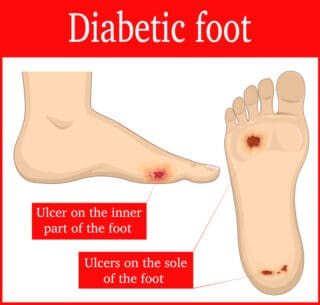
Largo Foot and Ankle Health Center
1450 Mercantile Lane
Suite 151
Upper Marlboro, MD 20774

More Podiatry Foot Care Articles
Diabetic Foot Ulcers and Neuropathy

A diabetic foot ulcer is an open sore or wound that occurs in approximately 15% of patients with diabetes and is commonly located on the bottom of the foot. Of those who develop a foot ulcer, 6% will be hospitalized due to infection or other ulcer-related complication.
Diabetes is the leading cause of non-traumatic lower extremity amputations in the U.S. People with diabetes should be especially careful with wounds. Approximately 14-24% of patients with diabetes who develop a foot ulcer will require an amputation. Foot ulceration precedes 85% of diabetes-related amputations.
Anyone who has diabetes can develop a foot ulcer. Native Americans, African Americans, Hispanics, and older men are more likely to develop ulcers. People who use insulin are at higher risk of developing a foot ulcer, as are patients with diabetes-related kidney, eye, and heart disease. Being overweight and using alcohol and tobacco also play a role in the development of foot ulcers.
Ulcers form due to a combination of factors, such as lack of feeling in the foot, poor circulation, foot deformities, irritation (such as friction or pressure), and trauma, as well as duration of diabetes. Patients who have diabetes for many years can develop neuropathy, a reduced or complete lack of ability to feel pain in the feet due to nerve damage caused by elevated blood glucose levels over time. The nerve damage often can occur without pain. A diabetic patient may have an open wound without even feeling it. Your podiatrist can test feet for neuropathy with a simple, painless tool called a monofilament.
Vascular disease can complicate a foot ulcer, reducing the body’s ability to heal and increasing the risk for an infection. Elevations in blood glucose can reduce the body’s ability to fight off a potential infection and also slow healing. Pay attention to any wound you have, and contact your podiatrist if you have any of the following:
- Signs of redness, swelling, oozing or drainage. If this has progressed significantly, odor may be present.
- Severe pain or numbness.
- Unexplained fever.
- Many times, the first thing you may notice is some drainage on your white socks.
While diabetes is a chronic disease for which there is no cure at this time, you can take steps to live a healthy life. Most of these problems can be avoided if your diabetes is managed well and you must see your doctor regularly.

















